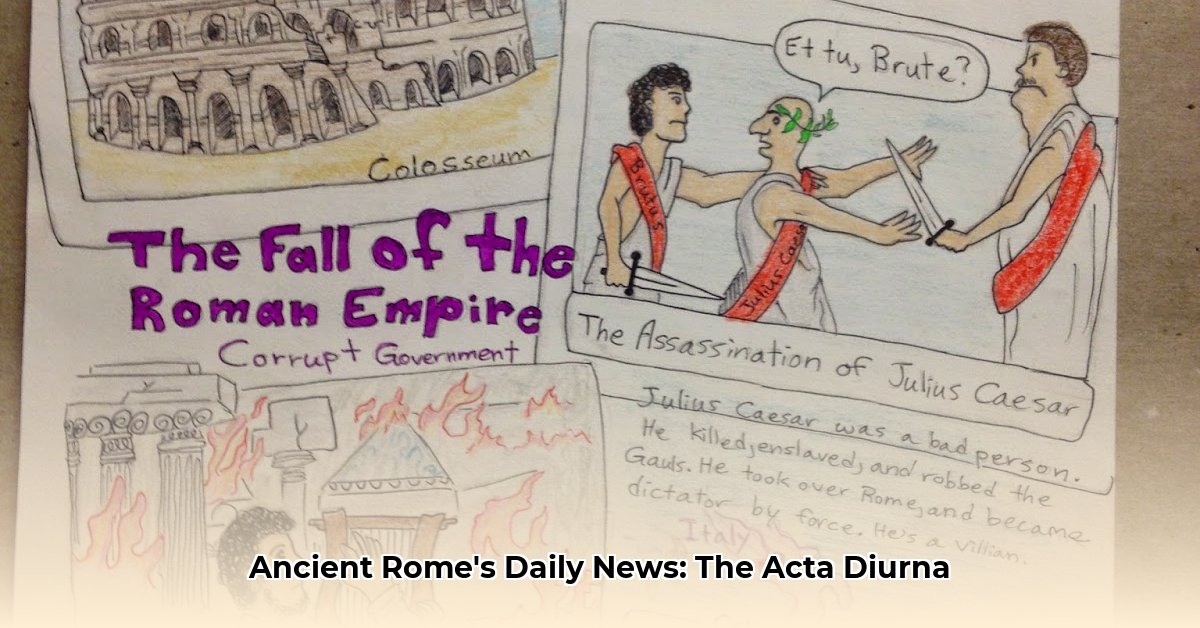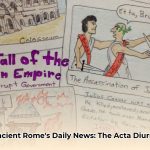Imagine being a citizen in ancient Rome, eager for the latest political decrees, military victories, or even local gossip, in an era utterly devoid of instant digital updates. How did vital information reach the bustling marketplaces, the grand forums, and the furthest corners of a vast empire? The answer lies in the Acta Diurna, or “Daily Acts”—Rome’s extraordinary answer to a daily newspaper, a fascinating precursor to our modern media landscape. This public gazette, meticulously updated and prominently displayed, served as the primary information hub for centuries, profoundly shaping Roman society and laying foundational elements for journalism. Read more about Acta Diurna to see its impact. Learn more about Roman news and its impact.
What Was the Acta Diurna? Rome’s Ancient Newspaper Defined
For the citizens of ancient Rome, staying informed required an ingenious solution in a world without printing presses, let alone the internet. Their innovation was the Acta Diurna, appearing as early as 131 BC. These daily bulletins were essentially public noticeboards, continuously updated and exhibited in high-traffic areas. They were Rome’s fundamental “daily newspapers,” a crucial system for the Roman populace to stay abreast of significant events and daily occurrences, fostering a sense of shared awareness across the city and beyond.
Unpacking the Content: What News Filled Rome’s Daily Gazette?
Beyond mere official proclamations, what truly captured the attention of the Roman public on these ancient news sheets? The Acta Diurna presented a remarkably diverse array of information, skillfully blending weighty affairs of state with the minutiae of daily life. Readers would find essential political news, detailing government decisions, senatorial decrees, and legislative updates. Legal proceedings were frequently reported, offering insights into Rome’s intricate judicial system, including summaries of major court cases and decisions.
The gazettes also offered more personal and human-interest stories: records of births, deaths, and weddings; accounts of gladiatorial bouts and other public games; and even news concerning the imperial family, providing a glimpse into their lives, even when they were not in Rome. Military updates were vital for an empire constantly expanding and defending its borders, featuring reports on battles, victories, and troop movements. And, yes, a touch of everyday gossip often peppered the reports, providing lighthearted social commentary and tales of the city’s elite. Stories like a loyal dog staying with its dead owner, an architect fixing a slanted building, or even detailed lists of divorces (which famously irked the philosopher Seneca) were not uncommon, ensuring the Acta Diurna was relevant and engaging to a broad spectrum of Roman citizens. This eclectic mix aimed to deliver a comprehensive, though undoubtedly curated, reflection of Roman society.
Crafting and Distributing the News: How Acta Diurna Reached the Roman People
Understanding the origins and comprehensive distribution of the Acta Diurna reveals much about Rome’s administrative sophistication and its early grasp of public information. While earlier, informal methods of public announcements existed, Julius Caesar is widely credited with formalizing and mandating the daily publication of the Acta Diurna around 59 BC. As consul, Caesar shrewdly recognized the potent influence of publicly accessible information, especially as a means to weaken the Senate by making their previously private deliberations public. This groundbreaking decision transformed the Acta Diurna from sporadic notices into a consistent, official public record.
But precisely how was this news crafted and disseminated across the sprawling empire? Dedicated scribes, often enslaved, played a pivotal role. These professional note-takers would record proceedings from the Senate and courts, collect information from various officials, and even scour the city for news tips. They meticulously copied the day’s intelligence onto these daily bulletins.
The materials used for the Acta Diurna remain a subject of historical debate. Early forms were likely inscribed on durable materials such as metal or stone tablets, or whitewashed wooden boards (album), designed for repeated public display. Later, more perishable materials like low-grade papyrus (saitic or taenotic papyrus) might have been used for wider, though less permanent, circulation, which explains why no intact copies have survived to the present day due to decomposition.
These inscribed or written tablets and sheets were then prominently displayed in bustling public spaces, most notably the Roman Forum, the heart of Roman civic life. This central location ensured maximum visibility. Given that a significant portion of the Roman population was illiterate, these public postings were often read aloud by street criers (praecones) or by literate citizens to groups gathered around them, effectively bridging the literacy gap and ensuring the news reached everyone.
Furthermore, to extend its reach beyond the capital, copies were systematically dispatched to provincial governors, wealthy families, and military camps by couriers and merchants. This extensive network ensured that significant information, official mandates, and even public speeches (sometimes transcribed with interruptions noted) were widely publicized (publicare et propagare) across the vast Roman territories, making the Acta Diurna truly a vehicle for empire-wide communication.
The Acta Diurna’s Profound Influence on Roman Life and Governance
The influence of the Acta Diurna on Roman society was multifaceted, extending far beyond simple information delivery. These ancient “newspapers in ancient Rome” fundamentally shaped how citizens perceived their world, their leaders, and their place within the empire.
One primary impact was its role in efficient information dissemination. How else would ordinary Romans consistently learn about new laws, senatorial decrees, the Emperor’s latest mandates, or critical military dispatches from distant frontiers? It served as an indispensable, centralized source of current events.
However, its purpose went deeper. The Acta Diurna functioned as a strategic tool for imperial control and propaganda. The Roman elite, from Caesar onward, understood the power of controlling the narrative, using the gazette to publish and promote their agenda, disseminate carefully selected information, and manage public perception—a process aptly described by the motto “Publicize And Propagate.” After Caesar’s assassination, Emperor Augustus, despite excluding Senate sessions from the published Acta, shrewdly continued its operation, understanding its utility as a tool for state communication and imperial authority.
Beyond its political utility, the Acta Diurna also provided an invaluable historical record. Renowned Roman historians, such as Tacitus and Suetonius, are known to have consulted information from the Acta Diurna for their own comprehensive accounts of contemporary events and the lives of emperors. For instance, Tacitus explicitly noted the eagerness with which these gazettes were consumed even in the distant provinces, stating: “The journal of the Roman people is scanned through the provinces and armies with double care for news of what Thrasea has done” (Annals 16.22). Pliny the Elder, too, recorded fascinating stories—including accounts of a dog’s extraordinary loyalty—that he discovered within the Acta Diurna. Seneca, the philosopher, famously complained about the extensive lists of divorces published, underscoring the gazette’s pervasive influence on social awareness and norms.
Despite its broad reach and influence, the Acta Diurna had inherent limitations. Its access was restricted by literacy rates, and the content was subject to potential bias and imperial control. The written word of the Acta thus worked in tandem with oral communication. Gossip, public speeches, and daily conversations in the bustling Roman marketplaces all contributed to the rapid spread of information, creating a vibrant, albeit sometimes unreliable, news ecosystem. The Acta Diurna likely served as a foundational source, with news then being amplified and disseminated further through these informal channels.
The Enduring Echoes: Acta Diurna’s Legacy in Modern Journalism
Are there discernible parallels between the Acta Diurna and our contemporary news sources? Absolutely. Both endeavors, separated by millennia, aim to inform the public, although the methods, speed, and global scale have vastly evolved. The Acta Diurna represents a pivotal, groundbreaking moment in the grand narrative of journalism and public communication. It serves as compelling proof that the Romans not only comprehended the concepts of transparency and propaganda but also profoundly understood the critical importance of keeping their populace engaged and informed.
While no complete, original copies of the Acta Diurna have survived the ravages of time, its enduring legacy is undeniable. It laid crucial groundwork for the evolution of modern newspapers and sophisticated news dissemination techniques. Its significance as a foundational precursor to contemporary journalism stands as a testament to Rome’s advanced approach to public communication. Though its circulation gradually dwindled from the 3rd century AD, especially after Emperor Constantine moved the seat of government to Constantinople around 330 AD, its core function and impact resonate even today.
Acta Diurna vs. Modern News: A Comparative Look
| Feature | Acta Diurna | Modern News |
|---|---|---|
| Dissemination | Public display on boards/tablets, copied by scribes, read aloud, couriers to provinces | Print (newspapers, magazines), digital platforms (websites, apps, social media), broadcast (TV, radio) |
| Content | Political decrees, military news, court cases, births/deaths, imperial family news, social gossip, human-interest stories, public works updates | Global events, politics, culture, economics, science, technology, entertainment, investigative journalism |
| Control/Bias | Potential for imperial control and propaganda; censorship by ruling powers | Corporate ownership influence, political biases, advertising pressures, ethical guidelines, citizen journalism |
| Accessibility | Limited by general literacy rates; widespread via public readings and word-of-mouth | Potentially limited by digital divide, subscription models; widespread via internet access |
| Fact-Checking | Less formalized; reliant on official reporting or scribal diligence | Established journalistic standards, rigorous fact-checking, cross-referencing, corrections policies |
| Interactivity | Primarily one-way communication | Two-way communication via comments, social media, citizen submissions |
| Longevity | Perishable materials (papyrus); physical records archived or lost; reliance on historical mentions | Digital archives, print archives; constant updates, real-time reporting |
Actionable Intelligence for Today: Lessons from the Acta Diurna
The legacy of the Acta Diurna offers valuable and actionable insights for various contemporary stakeholders, demonstrating enduring principles of communication and historical research that remain relevant in the digital age.
| Stakeholders | Short-Term (0-1 Year Focus) | Long-Term (3-5 Year Outlook) |
|---|---|---|
| Historians | Prioritize research on identifying more indirect references to Acta Diurna in newly translated or re-examined Roman texts, enhancing our understanding of their precise reach, content, and daily operational nuances. | Develop and refine sophisticated digital humanities projects, including interactive reconstructions of potential Acta Diurna content based on known societal events and comprehensive historical accounts, enriching scholarly resources and public accessibility. |
| Journalism Schools | Integrate the study of Acta Diurna into introductory journalism curricula as a foundational example of early news dissemination, emphasizing the historical evolution of media and the timeless importance of public information. | Analyze the Acta Diurna‘s effective content strategy—its blend of hard news and relatable social interest—for its enduring relevance to modern media engagement tactics, particularly in balancing civic reporting with audience appeal. |
| Museums & Cultural Institutions | Create compelling and accessible exhibits showcasing the Acta Diurna through interpretive displays, digital reconstructions, and multimedia presentations, highlighting its pivotal role in Roman society and its direct connection to modern news. | Develop immersive virtual reality (VR) or augmented reality (AR) experiences that simulate the Roman Forum environment, allowing visitors to interact with digital representations of the Acta Diurna and understand their historical context and societal impact firsthand. |
| Digital Media & Content Creators | Study the Acta Diurna‘s success in disseminating concise information widely despite technological limitations; apply lessons to strategies for impactful short-form content and effective public messaging in crowded digital spaces. | Explore the Acta Diurna‘s functional approach to “publicare et propagare” (to publish and propagate) to understand historical precedents for information control and dissemination, informing ethical considerations in contemporary content curation and platform design. |










